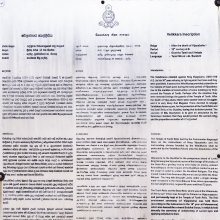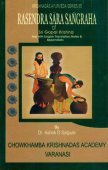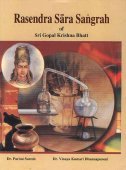Cula, Cūla, Cūḷā, Cūḷa: 17 definitions
Introduction:
Cula means something in Hinduism, Sanskrit, Buddhism, Pali, the history of ancient India, Marathi, Jainism, Prakrit, Hindi. If you want to know the exact meaning, history, etymology or English translation of this term then check out the descriptions on this page. Add your comment or reference to a book if you want to contribute to this summary article.
The Sanskrit terms Cūḷā and Cūḷa can be transliterated into English as Cula or Culia, using the IAST transliteration scheme (?).
Alternative spellings of this word include Chula.
Images (photo gallery)
In Hinduism
Jyotisha (astronomy and astrology)
Source: Wisdom Library: Brihat Samhita by VarahamihiraCūla (चूल) (Cf. Śikha) refers to the “tail” of Ketus (i.e., luminous bodies such as comets and meteors), according to the Bṛhatsaṃhitā (chapter 11), an encyclopedic Sanskrit work written by Varāhamihira mainly focusing on the science of ancient Indian astronomy astronomy (Jyotiṣa).—Accordingly, “Generally, if the luminous body or comet be small, clear, glossy, straight, transient, white and visible either immediately after their appearance or some time afterwards, there will be health and happiness in the land. If it be the opposite of these, or of the shape of the rainbow or with two or three tails [i.e., cūla—viśeṣataḥ dvitricūlo vā], mankind will not be happy”.

Jyotisha (ज्योतिष, jyotiṣa or jyotish) refers to ‘astronomy’ or “Vedic astrology” and represents the fifth of the six Vedangas (additional sciences to be studied along with the Vedas). Jyotisha concerns itself with the study and prediction of the movements of celestial bodies, in order to calculate the auspicious time for rituals and ceremonies.
India history and geography
Source: Wisdom Library: Teachers, Saints and SagesCūla (சூல) [=cūlam?] or simply Sula refers to one of the Siddhars (Siddhas) and Rishis mentioned by Rangarasa Desiga Swamigal in his Siddhargal Potri Thoguppu. Each name in the list starts with prefix ‘Om’ followed by the Siddhar’s names and ends with refrain ‘Thiruvadigal Potri’. For example for Cūla: ஓம் சூலமுனிவர் திருவடிகள் போற்றி [ōm cūlamuṉivar tiruvaṭikaḷ pōṟṟi].—These Siddhas experienced union with the ultimate reality and witnessed a spiritual transformation of their intellectual, mental, vital and ultimately, physical bodies.
Source: Cologne Digital Sanskrit Dictionaries: Indian Epigraphical GlossaryCūḻā.—(IA 11), tresses; cf. cūdā. Note: cūḻā is defined in the “Indian epigraphical glossary” as it can be found on ancient inscriptions commonly written in Sanskrit, Prakrit or Dravidian languages.

The history of India traces the identification of countries, villages, towns and other regions of India, as well as mythology, zoology, royal dynasties, rulers, tribes, local festivities and traditions and regional languages. Ancient India enjoyed religious freedom and encourages the path of Dharma, a concept common to Buddhism, Hinduism, and Jainism.
Languages of India and abroad
Pali-English dictionary
Source: BuddhaSasana: Concise Pali-English Dictionarycūla : (adj.) small; minor. || cūḷā (f.) crest; a lock of hair left on the crown of the head; cockscomb.
Source: Sutta: The Pali Text Society's Pali-English DictionaryCūḷā, (f.) (Vedic cūḍā. to cūḍa)=cūḷa, usually in sense of crest only, esp. denoting the lock of hair left on the crown of the head when the rest of the head is shaved (cp. Anglo-Indian chuḍā & Gujarāti choṭali) J.I, 64, 462; V, 153, 249 (pañcacūḷā kumārā); DhA.I, 294; as mark of distinction of a king J.III, 211; V, 187; of a servant J.VI, 135.—a cock’s comb J.II, 410; III, 265.
— or —
Cūḷa, (Sk. cūḍa & cūlikā) 1. swelling, protuberance; root, knot, crest. As kaṇṇa-cūḷa the root of an elephant’s ear J.VI, 488. aḍḍha-cūḷa a measure (see aḍḍha). See also cūlikā.—2. (adj.) see culla. (Page 271)

Pali is the language of the Tipiṭaka, which is the sacred canon of Theravāda Buddhism and contains much of the Buddha’s speech. Closeley related to Sanskrit, both languages are used interchangeably between religions.
Marathi-English dictionary
Source: DDSA: The Molesworth Marathi and English Dictionaryculā (चुला).—m culāṇa n cullā m (culli S) A large fireplace or cooking stove; a stove without a hob.
--- OR ---
cūla (चूल).—f (cūllī S) A fireplace; a semicircular erection of earth, to contain the fire in its cavity and support the cooking vessel on its rim. culīcēṃ lākūḍa culīntaca jaḷēla Firewood must come at last to the fireplace. culīcēṃ lākūḍa culīntaca jaḷāvēṃ or culīnta barēṃ Every thing should be used or disposed of in its own place. culīnta jāṇēṃ To go to pot (to be destroyed, spoiled, or lost). culīṃ- tūna nighūna vailānta paḍaṇēṃ To fall out of the frying pan into the fire. culīmadhyēṃ māñjarēṃ vyālīṃ āhēta Expresses extreme desolation or hard poverty. culīlā virajaṇa paḍaṇēṃ To be extinguished--the fire of the fireplace.
--- OR ---
cūḷa (चूळ).—m f (culaka S) The palm of the hand as hollowed to contain a liquid.
Source: DDSA: The Aryabhusan school dictionary, Marathi-Englishcūla (चूल).—f A fireplace. culīta khāṇēṃ Go to pot or to be destroyed.culīntūna nighūna vailānta paḍaṇēṃ To fall out of the frying pan into the fire. culīmadhyēṃ māñjarē vyālīṃ āhēta There is extreme desolution or poverty.
--- OR ---
cūḷa (चूळ).—m f The palm of the hand as hollowed to contain a liquid.
Marathi is an Indo-European language having over 70 million native speakers people in (predominantly) Maharashtra India. Marathi, like many other Indo-Aryan languages, evolved from early forms of Prakrit, which itself is a subset of Sanskrit, one of the most ancient languages of the world.
Sanskrit dictionary
Source: DDSA: The practical Sanskrit-English dictionaryCūla (चूल).—Hair.
-lā 1 An upper room.
2) A crest.
3) The crest of a comet; cf. चूडा (cūḍā).
Derivable forms: cūlaḥ (चूलः).
Source: Cologne Digital Sanskrit Dictionaries: Shabda-Sagara Sanskrit-English DictionaryCūlā (चूला).—f.
(-lā) 1. An upper room, a room on the top of a house. 2. A crest. E. cūl to rise, affixes aṅ and ṭāp: see cūḍā.
Source: Cologne Digital Sanskrit Dictionaries: Monier-Williams Sanskrit-English Dictionary1) Cula (चुल):—[from cul] [gana] 1. balādi (vula, [Kāśikā-vṛtti])
2) Cūla (चूल):—m. (= cūḍa), Name of a man, [Bṛhad-āraṇyaka-upaniṣad vi, 3, 9]
3) Cūlā (चूला):—[from cūla] f. the nucleus of a comet, [Varāha-mihira’s Bṛhat-saṃhitā xi, 9 and 21] (ifc.)
4) [v.s. ...] the tonsure ceremony, [Raghuvaṃśa iii, 28] (ifc.; caula, S)
5) [v.s. ...] a top-room of a house, [cf. Lexicographers, esp. such as amarasiṃha, halāyudha, hemacandra, etc.]
6) [v.s. ...] cf. uc-.
Source: Cologne Digital Sanskrit Dictionaries: Yates Sanskrit-English DictionaryCūlā (चूला):—(lā) 1. f. Upper room; crest.
[Sanskrit to German]
Sanskrit, also spelled संस्कृतम् (saṃskṛtam), is an ancient language of India commonly seen as the grandmother of the Indo-European language family (even English!). Closely allied with Prakrit and Pali, Sanskrit is more exhaustive in both grammar and terms and has the most extensive collection of literature in the world, greatly surpassing its sister-languages Greek and Latin.
Hindi dictionary
Source: DDSA: A practical Hindi-English dictionary1) Cula (चुल) [Also spelled chul]:—(nf) titillation, prurience; wantonness; sexual passion; —[uṭhanā] to have a titillating sensation, to be passionate, to have a sex urge; —[miṭānā] to satisfy one’s passion or sexual urge.
2) Cūla (चूल) [Also spelled chul]:—(nf) tenon; pivot; mortise; joint; ~[dāra] pivoted, tenoned; —[baiṭhanā] to fit in; —[se cūla milanā] to have complete adjustment, to have a harmonious relationship; [cūleṃ ḍhīlī honā] lit. the joints to become loose or dislocated; to be tired out, to be wearied, to be exhausted.
...
Prakrit-English dictionary
Source: DDSA: Paia-sadda-mahannavo; a comprehensive Prakrit Hindi dictionaryCūlā (चूला) in the Prakrit language is related to the Sanskrit word: Cūḍā.
Prakrit is an ancient language closely associated with both Pali and Sanskrit. Jain literature is often composed in this language or sub-dialects, such as the Agamas and their commentaries which are written in Ardhamagadhi and Maharashtri Prakrit. The earliest extant texts can be dated to as early as the 4th century BCE although core portions might be older.
Kannada-English dictionary
Source: Alar: Kannada-English corpusCūla (ಚೂಲ):—
1) [noun] a bunch of hairs (on the head).
2) [noun] the natural tuft on the top of the head of a peacock or the comb of a rooster.
3) [noun] the top of anything; summit; ridge.
--- OR ---
Cūḷa (ಚೂಳ):—[noun] = ಚೂಲ [cula].
--- OR ---
Cūḻa (ಚೂೞ):—[noun] = ಚೂಲ [cula].
Kannada is a Dravidian language (as opposed to the Indo-European language family) mainly spoken in the southwestern region of India.
Nepali dictionary
Source: unoes: Nepali-English DictionaryCūla (चूल):—n. 1. hair; 2. top-knot of hair; 3. pointed axle-arm; 4. pivot;
Nepali is the primary language of the Nepalese people counting almost 20 million native speakers. The country of Nepal is situated in the Himalaya mountain range to the north of India.
See also (Relevant definitions)
Starts with (+25): Cula Assapura Sutta, Cula Buddhaghosa, Cula Cunda, Cula Dhammasamadana Sutta, Cula Dukkhakkhandha Sutta, Cula Ekasataka, Cula Ganthipada, Cula Gavaccha, Cula Gopalaka Sutta, Cula Gosinga Sutta, Cula Jali, Cula Janaka Jataka, Cula Kala, Cula Kammavibhanga Sutta, Cula Magandiya, Cula Malunkya Sutta, Cula Moggallana, Cula Nidana Sutta, Cula Rahulovada Sutta, Cula Saccaka Sutta.
Query error!
Full-text (+313): Nicula, Shula, Trishula, Avacula, Pushpacula, Karnashula, Culamani, Culapanthaka, Parinamashula, Shirahshula, Parshvashula, Shuladharin, Shulahasta, Hricchula, Amasula, Dikshula, Svarnacula, Shulaghna, Katishula, Vatashula.
Relevant text
Search found 101 books and stories containing Cula, Chula, Cūla, Cuḻa, Culā, Cūḷā, Cūḷa, Cūlā, Cūḻā, Cūḻa, Cula-a, Cūla-a, Cūḷa-a, Cūḷa-a-ā, Culia-a, Culia-a-a, Soola, Sula; (plurals include: Culas, Chulas, Cūlas, Cuḻas, Culās, Cūḷās, Cūḷas, Cūlās, Cūḻās, Cūḻas, as, ās, Soolas, Sulas). You can also click to the full overview containing English textual excerpts. Below are direct links for the most relevant articles:
The Religion and Philosophy of Tevaram (Thevaram) (by M. A. Dorai Rangaswamy)
Chapter 4.6 - (f) Symbology of Trisula (the trident) < [Volume 2 - Nampi Arurar and Mythology]
The Pey, Putam and Paritam (different sorts of Ganas, attendants) < [Volume 2 - Nampi Arurar and Mythology]
Nayanar 29: Eyarkon Kalikama (Kalikkama) < [Volume 4.1.1 - A comparative study of the Shaivite saints the Thiruthondathogai]
Ayurvedic concept of hridroga its present relevance < [Volume 12 (issue 3-4), Jan-Jun 1993]
A critical study of the concept of amlapitta and parinamasula < [Volume 13 (issue 1-2), Jul-Dec 1993]
Mercurial, metallic, and mineral remedies for alimentary ailments. < [Volume 4 (issue 1), Jul-Sep 1984]
Maha Buddhavamsa—The Great Chronicle of Buddhas (by Ven. Mingun Sayadaw)
Part 5 - Discourses delivered by the Buddha with Reference to Venerable Rāhula < [Chapter 31 - The Monk Sudinna, the Son of the Kalanda Merchant]
(3) Third Pāramī: The Perfection of Renunciation (nekkhamma-pāramī) < [Chapter 6 - On Pāramitā]
Part 2 - Preaching the Ambalatthika Rahulovada Sutta < [Chapter 20 - The Six Princes achieved different Attainments]
Archives of Social Sciences of Religions
Hmong Messianism: Religious Dynamics as Political Instrument < [Volume 148 (2009)]
Nahua Colonial Discourse: Appropriating the European Other < [Volume 77 (1992)]
Amaravati Art in the Context of Andhra Archaeology (by Sreyashi Ray chowdhuri)
Epigraphs from Amarāvatī (j) The Stūpa site < [Chapter 4 - Survival of Amarāvatī in the Context of Andhra Art]
Brahma Purana (critical study) (by Surabhi H. Trivedi)
Appendix 11 - Alphabetical list of Hells
15. List of Weapons < [Chapter 11 - Political Structure]
18. Courses of study, priestly and vocational < [Social Structure]
Related products




